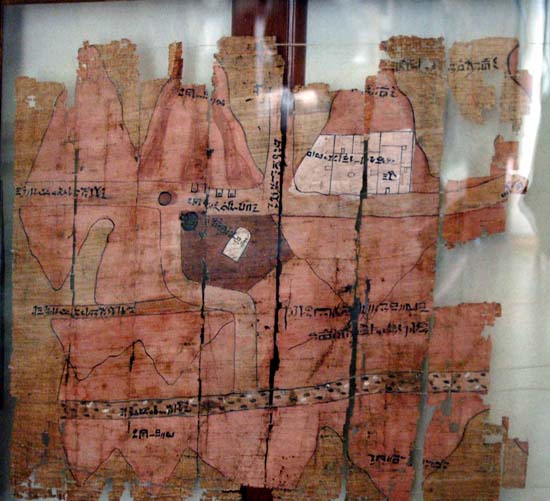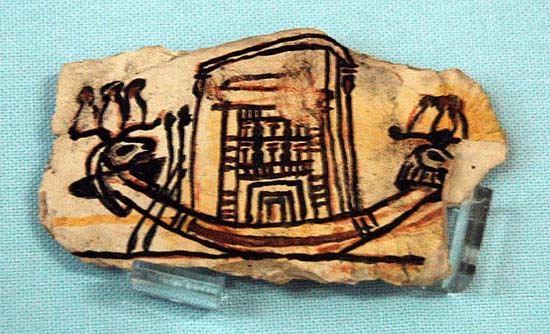Documents from Deir el Medina
 Papyrus
Papyrus
 Among
the remains Champollion found 50 pieces of a manuscript which lists
over 300 Egyptian rulers and foreign rulers. He recognized the
importance of this document with his unique ability to translate -
without which these scraps of history would have been lost forever.
No other pieces of the papyri could be found, and this has caused
gaps in the list, he wrote to his brother "I confess that the
greatest disappointment of my literary life is to have discovered
this manuscript in such a desperate state. I will never console
myself - it is a wound which bleed for a long time".
Among
the remains Champollion found 50 pieces of a manuscript which lists
over 300 Egyptian rulers and foreign rulers. He recognized the
importance of this document with his unique ability to translate -
without which these scraps of history would have been lost forever.
No other pieces of the papyri could be found, and this has caused
gaps in the list, he wrote to his brother "I confess that the
greatest disappointment of my literary life is to have discovered
this manuscript in such a desperate state. I will never console
myself - it is a wound which bleed for a long time".
Other important documents were also included in the same collection - including the Gold Mines map and the plan of Ramesses IV's tomb in the Valley of the Kings. Its thought that these, and other document, such as the Judicial Papyrus recording a plot against Ramesses III, had once formed a part of the same government archive and that they had originated in Medinet Habu. Medinet Habu was the administrative headquarters of Thebes [Western] at the end of the New Kingdom and was a very short distance from the village. Also the villagers were moved into here when their safety was at risk later in during the period leading to the 3rd Intermediate Period.
'The Tale of Setne-Khaemwaset' is one of the most interesting stories documented and it was also found at Deir el Medina - not in a ancient tomb of but that of a 3rd century BC Coptic Monk. It is curious that a Monk, often associated with destroying pagan objects, should have collected this and other documents, which were buried with him. The story was written in Demotic and 4, of 6, pages were found.
-
 Late
Ramessid Letters
Late
Ramessid Letters - Henry Salt, who arrived in Egypt in March 1816 as the British Consul-General, managed to gather enough material to sell 3 collections of finds. Many documents were to Europe in 1818 and they included some from the Deir el Medina family archive - collectively known as the Late Ramessid Letters.
The text of letter 28 says "To the fan-bearer , royal scribe and general, high priest of Amun-Re, king of the gods, viceroy of Kush, ... Piankh, from the two chief workmen, the scribe of the necropolis, Buteshamun, the guardian of Kar. In life, prosperity and health and in the favour of Amun-Re, king of the gods. We have noted all matters about which our lord had written us... saying "Uncover a tomb among the ancestors and preserve its seal until I return", so said he our Lord. We are doing commissions. We shall cause you to find seal still affixed made read is that of which we know.
Its suggested that this is Paiankh using the treasure from a tomb to finance his campaign into Nubia (against Panehsy) and it was 'official' removal not robbing that removed much of the treasure from the Valley of the Kings. Piankh was High Priest and General in the 20th Dynasty. There is question whether he preceded or succeeded Herihor, based on the above we could calculate that he succeeded. Herihor broke away form the central control and established a virtually separate kingdom based on the High Priesthood of Amun at Thebes. Piankh was Herihor's son or son-in-law. Piankh was succeeded by his son, Pinudjem I. Pinudjem I was also High Priest of Amun at Thebes, which was now an established near-royal dynasty.
Panehsy was a Viceroy of Kush in the 20th Dynasty and had been appointed by Ramesses XI (later King in the dynasty). He helped send Amenhotep (High Priest of Karnak) into exile and controlled much of southern Egypt. He was eventually pushed back into Nubia, by Herihor [who succeeded Piankh], where he lived to an old age. This was the last time Nubia was a province of Egypt.
- Library of the scribe Kenherkhepshef
- Bernard Bruyère excavated a number of tombs from the village. In 1928 a shaft between two tomb revealed a cache of documents. This was a cache of different types of documents and their importance was partially lost because they were divided, some to London (BM) and some to Dublin (Chester Beatty). Along with other earlier papyri this was part of a large library collected or gathered by a worker form the village - the scribe Kenherkhepshef.
- Kenherkhepshef was already known from documents and his visibility started in Year 33 of Ramesses II (Usermaatra Setepenra, 1279-1213 BC), becoming scribe in Year 40 and continuing until the end of Sety II's (Userkheperura Setepenra, 1200-1194 BC) reign. However his reputation was for being a poor official, lax in his duties and corrupt. His passion was his library which had a wide ranging of subject matter - how he collected it is another question. After his death his family kept the rolls of Papyrus, but they became less values and eventually re-used as scrap.
- One of the Late Ramesside Letters written at the end of the New Kingdom by scribe Djehutymose to his son (the scribe of the tomb Butehamun) reported "Now as far as the documents onto which the sky rained in the house of the scribe Horsheri, my grandfather, you brought them out and found that they had not become erased. I said to you I will unbind them again. You brought them down below and we deposited in the tomb of Amennakht my great grandfather." The location matches and there is water damager to a Chester Beatty papyrus. The library became unwanted and was put into a tomb, not to destroy it but to remove an unwanted collection.
The contents are a very interesting mixture - almost as if Kenherkhepshef was searching for things to keep him alive and well for longer (he was also known to have a 12 year old wife). The library contained:
| Chester Beatty I | Contendings of Horus and Seth, love songs, hymns praising Ramesses IV, cattle sale document | |
| Chester Beatty II | Story of the Blinding and Vindication of Truth | |
| Chester Beatty III | how to interpret dreams book, battle of Kadesh, letter to Vizier Panehsy; dreams included "if a man sees himself shaving his lower parts, BAD it means mourning" | |
| Chester Beatty IV | hymns, students notes and doodles | |
| Chester Beatty V | Hymn to the Nile, magical texts, short texts in letter form | |
| Chester Beatty VI | medical prescriptions and text | |
| Chester Beatty VII | magical spells against scorpions; spells against fever etc. | |
| Chester Beatty VIII | magic-religious texts | |
| Chester Beatty IX | Ritual of Amenhotep I, part of magical text, book of protection, book of invocations | |
| Chester Beatty X | part of a book of aphrodisiacs | |
| Chester Beatty XI | Story of Isis and Re, magical texts, accounts, spells of safety on the river, hymn to Amun | |
| Chester Beatty XII | parts of magical text with mythological allusions | |
| Chester Beatty XIII | magical text | |
| Chester Beatty XIV | religious text | |
| Chester Beatty XV | magic-medical text | |
| Chester Beatty XVI | magical text, accounts | |
| Chester Beatty XVII | extracts of satirical letter of Hori | |
| Chester Beatty XVIII | miscellaneous letter, medical text | |
| Chester Beatty XIX | extract on the satire on the Trades | |
| Deir el Medina I | Teaching of Ani, magical texts | |
| Deir el Medina II | part of Naunakhte II-III | |
| Deir el Medina III-XVI | letters | |
| Deir el Medina XVII | list of bronze utensils | |
| Naunakhte I-IV | will documents | |
| Geneva | incantation against scorpion strings, notes |
-
 Ostraca
Ostraca - In 1888 Georges Daressy made a number of finds in Egypt. He was Maspero's French assistant from the Bulaq Museum and this period was his very 1st archaeological work. He was searching the Valley of the Kings, in the tomb of Ramesses VI (KV9) and Ramesses IX (KV6) which had been open since antiquity. He found a number of stelae and also a large number of Ostraca, around 300, with preliminary sketches and 'doodles'. Most were recovered from KV9 and were the work of two draftsmen from Deir el Medina - Amenhotep and Nebnufer.